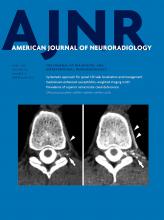Research ArticleAdult Brain
Open Access
Moving Toward a Consensus DSC-MRI Protocol: Validation of a Low–Flip Angle Single-Dose Option as a Reference Standard for Brain Tumors
K.M. Schmainda, M.A. Prah, L.S. Hu, C.C. Quarles, N. Semmineh, S.D. Rand, J.M. Connelly, B. Anderies, Y. Zhou, Y. Liu, B. Logan, A. Stokes, G. Baird and J.L. Boxerman
American Journal of Neuroradiology April 2019, 40 (4) 626-633; DOI: https://doi.org/10.3174/ajnr.A6015
K.M. Schmainda
aFrom the Departments of Biophysics (K.M.S., M.A.P.)
bRadiology (K.M.S., S.D.R.)
M.A. Prah
aFrom the Departments of Biophysics (K.M.S., M.A.P.)
L.S. Hu
eDepartments of Radiology (L.S.H., Y.Z.)
C.C. Quarles
gDivision of Imaging Research (C.C.Q., N.S., A.S.), Barrow Neurological Institute, Phoenix, Arizona
N. Semmineh
gDivision of Imaging Research (C.C.Q., N.S., A.S.), Barrow Neurological Institute, Phoenix, Arizona
S.D. Rand
bRadiology (K.M.S., S.D.R.)
J.M. Connelly
cNeurology (J.M.C.)
B. Anderies
fNeurosurgery (B.A.), Mayo Clinic, Scottsdale, Arizona
Y. Zhou
eDepartments of Radiology (L.S.H., Y.Z.)
Y. Liu
dDivision of Biostatistics, Institute for Health and Society (Y.L., B.L.), Medical College of Wisconsin, Milwaukee, Wisconsin
B. Logan
dDivision of Biostatistics, Institute for Health and Society (Y.L., B.L.), Medical College of Wisconsin, Milwaukee, Wisconsin
A. Stokes
gDivision of Imaging Research (C.C.Q., N.S., A.S.), Barrow Neurological Institute, Phoenix, Arizona
G. Baird
hDepartment of Diagnostic Imaging (J.L.B., G.B.), Rhode Island Hospital and Warren Alpert Medical School of Brown University, Providence, Rhode Island.
J.L. Boxerman
hDepartment of Diagnostic Imaging (J.L.B., G.B.), Rhode Island Hospital and Warren Alpert Medical School of Brown University, Providence, Rhode Island.

REFERENCES
- 1.↵
- Donahue KM,
- Krouwer HGJ,
- Rand SD, et al
- 2.↵
- Schmainda KM,
- Rand SD,
- Joseph AM, et al
- 3.↵
- Kong DS,
- Kim ST,
- Kim EH, et al
- 4.↵
- 5.↵
- Schmainda KM,
- Zhang Z,
- Prah M, et al
- 6.↵
- 7.↵
- Hu LS,
- Eschbacher JM,
- Heiserman JE, et al
- 8.↵
- 9.↵
- Paulson ES,
- Schmainda KM
- 10.↵
- Boxerman JL,
- Schmainda KM,
- Weisskoff RM
- 11.↵
- Hu LS,
- Baxter LC,
- Pinnaduwage DS, et al
- 12.↵
- Boxerman JL,
- Prah DE,
- Paulson ES, et al
- 13.↵
- Schmainda KM,
- Prah MA,
- Rand SD, et al
- 14.↵
- 15.↵
- Ellingson BM,
- Bendszus M,
- Boxerman J, et al
- 16.↵
- Leu K,
- Boxerman JL,
- Ellingson BM
- 17.↵
- Semmineh NB,
- Bell LC,
- Stokes AM, et al
- 18.↵
- 19.↵
- 20.↵
- Prah MA,
- Stufflebeam SM,
- Paulson ES, et al
- 21.↵
- Bedekar D,
- Jensen T,
- Rand S, et al
- 22.↵
- Altman DG
- 23.↵
- McBride GB
- 24.↵
- 25.↵
- Oh J,
- Henry RG,
- Pirzkall A, et al
- 26.↵
- Lev MH,
- Ozsunar Y,
- Henson JW, et al
- 27.↵
- Aronen HJ,
- Gazit IE,
- Louis DN, et al
- 28.↵
- 29.↵
- Law M,
- Young RJ,
- Babb JS, et al
- 30.↵
- 31.↵
- 32.↵
- Hu LS,
- Eschbacher JM,
- Dueck AC, et al
- 33.↵
- 34.↵
- Mangla R,
- Singh G,
- Ziegelitz D, et al
- 35.↵
- Prince MR,
- Zhang HL,
- Roditi GH, et al
- 36.↵
- 37.↵
- 38.↵
- Law M,
- Cha S,
- Knopp EA, et al
- 39.↵
- Law M,
- Oh S,
- Babb J, et al
In this issue
American Journal of Neuroradiology
Vol. 40, Issue 4
1 Apr 2019
Advertisement
K.M. Schmainda, M.A. Prah, L.S. Hu, C.C. Quarles, N. Semmineh, S.D. Rand, J.M. Connelly, B. Anderies, Y. Zhou, Y. Liu, B. Logan, A. Stokes, G. Baird, J.L. Boxerman
Moving Toward a Consensus DSC-MRI Protocol: Validation of a Low–Flip Angle Single-Dose Option as a Reference Standard for Brain Tumors
American Journal of Neuroradiology Apr 2019, 40 (4) 626-633; DOI: 10.3174/ajnr.A6015
0 Responses
Moving Toward a Consensus DSC-MRI Protocol: Validation of a Low–Flip Angle Single-Dose Option as a Reference Standard for Brain Tumors
K.M. Schmainda, M.A. Prah, L.S. Hu, C.C. Quarles, N. Semmineh, S.D. Rand, J.M. Connelly, B. Anderies, Y. Zhou, Y. Liu, B. Logan, A. Stokes, G. Baird, J.L. Boxerman
American Journal of Neuroradiology Apr 2019, 40 (4) 626-633; DOI: 10.3174/ajnr.A6015
Jump to section
Related Articles
- No related articles found.
Cited By...
- Multisite Benchmark Study for Standardized Relative CBV in Untreated Brain Metastases Using the DSC-MRI Consensus Acquisition Protocol
- "Synthetic" DSC Perfusion MRI with Adjustable Acquisition Parameters in Brain Tumors Using Dynamic Spin-and-Gradient-Echo Echoplanar Imaging
- Identification of a Single-Dose, Low-Flip-Angle-Based CBV Threshold for Fractional Tumor Burden Mapping in Recurrent Glioblastoma
- Arterial Spin-Labeling and DSC Perfusion Metrics Improve Agreement in Neuroradiologists Clinical Interpretations of Posttreatment High-Grade Glioma Surveillance MR Imaging--An Institutional Experience
- The Choroid Plexus as an Alternative Locus for the Identification of the Arterial Input Function for Calculating Cerebral Perfusion Metrics Using MRI
- DSC Perfusion MRI-Derived Fractional Tumor Burden and Relative CBV Differentiate Tumor Progression and Radiation Necrosis in Brain Metastases Treated with Stereotactic Radiosurgery
- Performance of Standardized Relative CBV for Quantifying Regional Histologic Tumor Burden in Recurrent High-Grade Glioma: Comparison against Normalized Relative CBV Using Image-Localized Stereotactic Biopsies
- Perfusion MRI-Based Fractional Tumor Burden Differentiates between Tumor and Treatment Effect in Recurrent Glioblastomas and Informs Clinical Decision-Making
This article has not yet been cited by articles in journals that are participating in Crossref Cited-by Linking.
More in this TOC Section
Similar Articles
Advertisement











